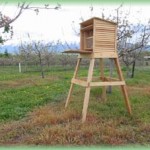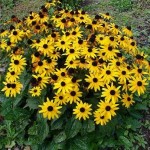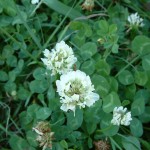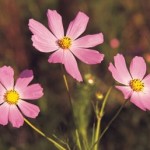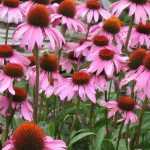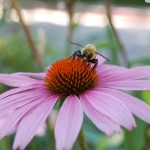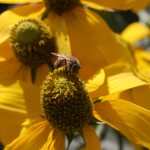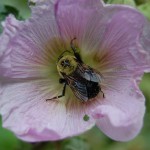San Francisco Chronicle, August 19, 2008
The U.S. Environmental Protection Agency is refusing to disclose records about a new class of pesticides that could be playing a role in the disappearance of millions of honeybees in the United States, a lawsuit filed Monday charges.
The Natural Resources Defense Council wants to see the studies that the EPA required when it approved a pesticide made by Bayer CropScience five years ago.
The environmental group filed the suit as part of an effort to find out how diligently the EPA is protecting honeybees from dangerous pesticides, said Aaron Colangelo, a lawyer for the group in Washington.
In the last two years, beekeepers have reported unexplained losses of hives - 30 percent and upward - leading to a phenomenon called colony collapse disorder. Scientists believe that the decline in bees is linked to an onslaught of pesticides, mites, parasites and viruses, as well as a loss of habitat and food.
$15 billion in crops
Bees pollinate about one-third of the human diet, $15 billion worth of U.S. crops, including almonds in California, blueberries in Maine, cucumbers in North Carolina and 85 other commercial crops, according to the U.S. Department of Agriculture. Not finding a cause of the collapse could prove costly, scientists warn.
Representatives of the EPA said they hadn't seen the suit and couldn't comment.
Clothianidin is the pesticide at the center of controversy. It is used to coat corn, sugar beet and sorghum seeds and is part of a class of pesticides called neonicotinoids. The pesticide was blamed for bee deaths in France and Germany, which also is dealing with a colony collapse. Those two countries have suspended its use until further study. An EPA fact sheet from 2003 says clothianidin has the potential for toxic chronic exposure to honey bees, as well as other pollinators, through residues in nectar and pollen.
The EPA granted conditional registration for clothianidin in 2003 and at the same time required that Bayer CropScience submit studies on chronic exposure to honeybees, including a complete worker bee lifecycle study as well as an evaluation of exposure and effects to the queen, the group said. The queen, necessary for a colony, lives a few years; the workers live only six weeks, but there is no honey without them.
"The public has no idea whether those studies have been submitted to the EPA or not and, if so, what they show. Maybe they never came in. Maybe they came in, and they show a real problem for bees. Maybe they're poorly conducted studies that don't satisfy EPA's requirement," Colangelo said.
Request for records
On July 17, after getting no response from the EPA about securing the studies, the environmental group filed a request under the Freedom of Information Act, which requires the records within 20 business days absent unusual circumstances.
When the federal agency missed the August deadline, the group filed the lawsuit, asking the U.S. District Court in Washington, D.C., to force the EPA to turn over the records.
Greg Coffey, a spokesman for Bayer CropScience in Research Triangle Park, N.C., said controlled field studies have demonstrated that clothianidin, when used correctly, will not harm bees. He added that all of EPA's requirements for conditional registration of clothianidin have been submitted to the agency.
An EPA spokesman, Dale Kemery, said the agency couldn't comment on the documents required under the conditional registration because the matter is the subject of litigation.
Unusual circumstances
Generally, the EPA has taken the position that the bee deaths occurred under unusual circumstances. In Germany, the corn lacked a seed coating that ensured that the pesticide stuck to the seed, and equipment blew the pesticide into a nearby canola field where bees fed.
The EPA is "reasonably confident" that a bee kill similar to Germany's wouldn't happen in the United States because use is restricted to commercial applicators who use stickier coatings, according to Kemery.
But because the stickier coatings aren't required, Kemery said, the EPA will review its policies on seed-treatment labels.
In California, according to the 2006 Pesticide Use Report Summary, about 3 pounds of clothianidin was used, all on corn. Other members of the neonicotinoid class, registered for a longer period of time, have been used more frequently, including 127,000 pounds on broccoli, grapes, lettuce and oranges. Some pesticides were used in buildings.
"We've been monitoring the bee die-off situation for a couple of years, and it's a complex puzzle that may also involve mites, viruses and other factors," said Glenn Brank, communications director for the state Department of Pesticide Regulation.
The agency is conducting its own review of environmental data from registered neonicotinoid pesticides as well as watching enforcement reports from counties for any unusual environmental incidents involving bees, he said. None was noted, Brank said.
Scientists presenting at the American Chemical Society national meeting Monday reported that dozens of pesticides had been found in samples of adult bees, broods, pollen and wax collected from honeybee colonies suspected to have died from symptoms of colony collapse disorder, including some neonicotinoids.
Entomologist Gabriela Chavarria, director of Natural Resources Defense Council's Science Center, said over the years bees have had to withstand devastating problems.
Bees pick up deadly farm and home chemicals when they visit flowers, or encounter chemical drift from aerial and other applications. Fifteen years ago, queen bees imported from China brought varroa mites that attacked broods of worker bees. Microscopic tracheal mites invade the hives.
And now the new pesticide, clothianidin, is another problem, Chavarria said. Scientists must find out whether the toxicity has been sufficiently studied, she said.
"We want this information now. We cannot continue to wait. Bees are disappearing. Our whole existence depends on them because we eat. The flowers need to be pollinated, and the only ones to do it are the bees."
Colony collapse
Honeybees, which pollinate everything from almonds to apples to avocados, began abandoning their colonies in 2006, destroying about a third of their hives.
Since then, their numbers have not improved. A survey of beekeepers in the fall and winter 2007 by the Bee Research Lab and the Apiary Inspectors of America showed that beekeepers lost about 35 percent of their hives compared with 31 percent in 2006.
See also:
· Mass death of bees in Germany: Approval of Bayer´s pesticide Poncho suspended www.cbgnetwork.de/2517.html
· The Guardian: Germany bans chemicals linked to honeybee devastation
· Sierra Club urges EPA to suspend nicotinyl insecticides: www.sierraclub.org/biotech/whatsnew/whatsnew_2008-07-30.asp
· Press Release of the Research Centre for Cultivated Plants (German): www.jki.bund.de/cln_044/nn_813794/DE/pressestelle/Presseinfos/2008/1605__BienensterbenClothianidin.html__nnn=true
· Bee-keepers and environmental groups demand prohibition of pesticide "Gaucho"
· French Institutes Finds Imidaproclid Turning Up in Wide Range of Crops
2003 report from the "Comité Scientifique et Technique de l’Etude Multifactorielle des Troubles des Abeilles" http://agriculture.gouv.fr/IMG/pdf/rapportfin.pdf


